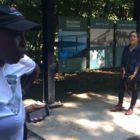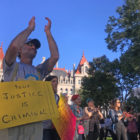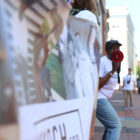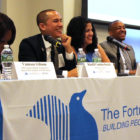
New York’s March for Justice
|
They were white and black, young and old, gay, trans and straight, putting themselves on the line for what the organizer called the civil rights movement for the 21st century.
Juvenile Justice Information Exchange (https://jjie.org/series/from-the-bureaus/page/17/)

They were white and black, young and old, gay, trans and straight, putting themselves on the line for what the organizer called the civil rights movement for the 21st century.

The first time I met the organizer of the March for Justice she told me to shut up. She put it more politely, but that was the meaning all the same.
I was milling about in the lobby of the Beacon Light Tabernacle Seventh Day Adventist Church in the Hudson Valley in New York state half-asleep, chatting with marchers about what in the hell would bring them out on a cold, rainy early Sunday morning when I heard it.

At the midpoint of the 180-mile March for Justice, its organizer, Soffiyah Elijah, was overwhelmed. She was simultaneously trying to find the proper turn on a back road in a Hudson Valley town, coordinate with the caretaker of a 105-year-old woman who wanted to join the march and figure out where to find a laundromat that would stay open late.

After a 180-mile hike that began in Harlem in Manhattan on Aug. 26, the March for Justice arrived in Albany, New York, this morning.

When she was in the sixth grade, when she still wanted to be a pediatrician and not a lawyer for revolutionaries, Soffiyah Elijah entered her first integrated school in Hempstead, Long Island. She remembers that in response to integration the administration of the school then segregated the classrooms. So she spent her first day in an integrated school among all black students.

The civil rights marchers had gone about a mile and change into Wappinger Falls, a quaint village in Dutchess County, New York, when it was time for a bathroom break.

With her 2-year-old son perched on her shoulders, Tomiqua Williams, 30, carefully guided her 5-year-old daughter’s wheelchair to the edge of the sidewalk...

When Carlos Jennings got out of prison in 2014, he wanted to kill the person who helped put him there.
“I wasn’t home seven days after doing 10 years in jail, and I’m in the car with somebody else, with a gun in my hand, trying to do something to somebody,” he said.

California’s juvenile prisons have long had a poor reputation as mere stops on the way to grown-up prisons, overcrowded places where reform or rehabilitation were rarely achieved.

Leyla Martinez didn’t expect to be accepted to Columbia University. She applied to demonstrate a lesson — not to limit himself — to her then-16-year-old son. She was 40, a single mother and formerly incarcerated, not the typical Columbia applicant.